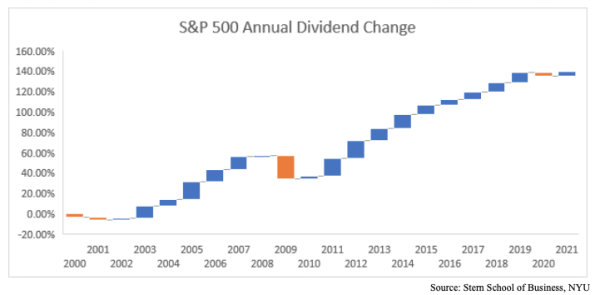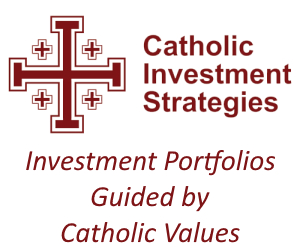Column: The Catholic Investor
It’s a matter of priorities
If you’re counting on dividend payments to supplement your income, then the single most important issue is whether the companies that you’re counting on for those dividends have the financial wherewithal to make the payments.
And that’s why we try to ensure, in one way or another, that the companies we include in our dividend income focused portfolios will be able to continue their dividend payments, and actually increase them, over time.
Recessions can create problems
While over the long-term the direction of dividends paid by companies in the S&P 500 has most definitely been up, that does not mean that the trip has been uninterrupted.

The recession impacted years of 2000, 2001, 2009, and 2020 all saw dividend cuts (orange-colored bars).
Most recently, during the pandemic shutdown, the annual dividend of the S&P fell nearly 4% in 2020 from its level a year earlier. That’s actually much better than the almost 23% decline in 2009 in the aftermath of the Great Recession.
If a new recession materializes over the coming months, then it would not be unusual to experience another dividend decline.
It’s possible that a company may have a long and storied history of earnings growth as well as rising dividends. That fact alone, though, does not necessarily mean that it is a wise choice for dividend income at the present time.
If a company’s financial condition becomes precarious, there is a significant risk that company management will elect, or be forced by circumstances, to reduce or eliminate the dividend.
A case in point is General Electric.
General Electric
Founded 130 years ago in 1892 by Thomas Edison, the company, at $161 billion, was the sixth largest US stock by market value at year-end 2008. At that point, GE was among the bluest of the blue-chip stocks having grown its dividend over the past 20 years at an average compound rate of 12.3% compared to just 5.5% for the S&P 500. But GE’s businesses, which included power generation, medical devices, financial services, and oil field equipment, were in trouble.
During the “Great Recession”, the company responded to operating weakness with dividend cuts in 2009 and 2010 from the $9.92 level of 2008. As the  economy recovered, so did the size of the dividend. From $3.68 in 2010, the dividend had risen back to $7.44 per share in 2016. But the company then undertook a series of dividend cuts culminating in a rate of just $.32 per share for 2019 and beyond. (Source: YCharts)
economy recovered, so did the size of the dividend. From $3.68 in 2010, the dividend had risen back to $7.44 per share in 2016. But the company then undertook a series of dividend cuts culminating in a rate of just $.32 per share for 2019 and beyond. (Source: YCharts)
GE’s market cap fell with the dividend, hitting $103 billion by year-end 2021, a fall of over 35% which dropped it to the 85th largest US stock. The fact that its stock market value only dropped 35% is rather remarkable as the company’s dividend cratered by nearly 97% at the same time dividends paid by the S&P 500 increased by 108%.
GE is a good example of what we believe is wrong with the Dividend Aristocrat approach to dividend investing. This strategy simply makes a portfolio of S&P 500 member companies that have paid continually increased dividends over the last 25 years. It is refreshed annually, so changes taking place over the course of a year are ignored. There is no discrimination based on yield or the likelihood of a company’s ability to maintain or increase its dividend in the future. Additionally, there is no consideration of whether a company is a permissible holding under the USCCB Socially Responsible Investment Guidelines.
What lessons can we learn from GE?
While a solid history of rising dividends can be an easy and significant metric, it should not be the only selection criterion. Likewise, a high yield, while attractive for investors seeking income, can be a warning sign of deteriorating operating results and a lack of dividend sustainability.
First and foremost, dividend safety must be a priority. There is no safe way to invest for dividend income without ongoing monitoring of the companies held in your portfolio. Even with continual review, surprises can occur. A successful dividend portfolio requires active management; there is no option to simply “buy and hold” that will work.
Diversification can help, too. The sting of an unanticipated dividend cut is much less if it affects just one of several stocks than if it hits the only stock you own.
And lastly, if you wish to build a dividend portfolio that harmonizes with your Catholic faith, it is essential to know which stocks to avoid for moral reasons.
—
Thomas "Tom" Carroll, CFA, is the president of Catholic Investment Strategies, a position in which he has passionately enjoyed serving since 2012. Prior to this position,... MORE »



You must be logged in to post a comment.